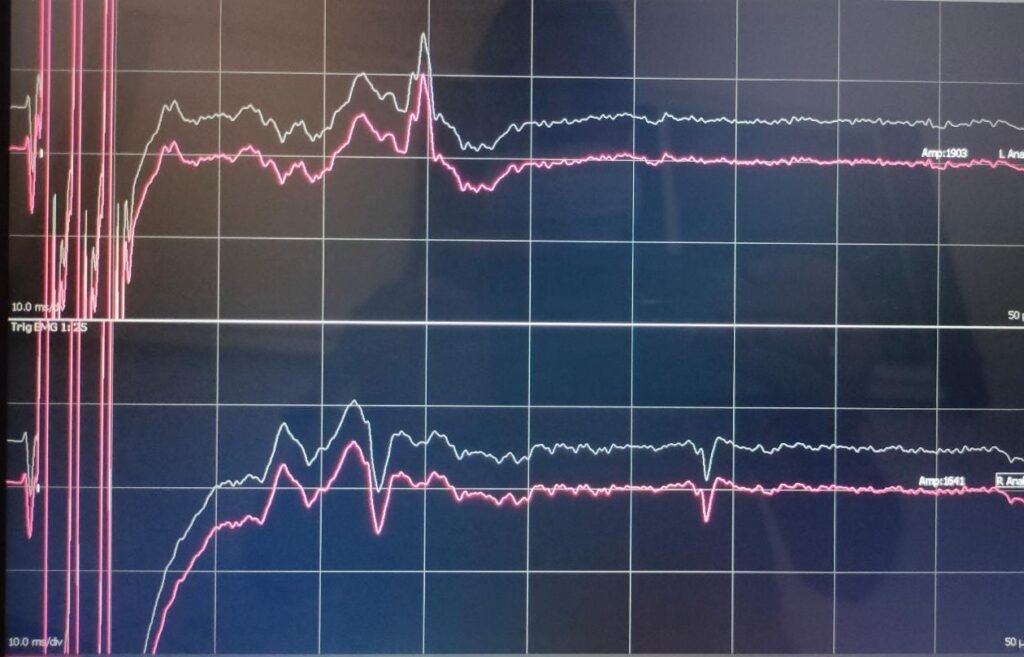Introduction, IONM In Meningomyelocele ?
- Meningomyelocele is a type of neural tube defect characterized by the incomplete closure of the spinal column during fetal development. This results in a sac-like protrusion of the spinal cord and its protective covering (meninges) through an opening in the vertebrae. Meningomyelocele can lead to various neurological issues and may require surgical intervention shortly after birth to reduce the risk of infection and further neurological damage. Treatment often involves surgical closure of the defect and ongoing medical management to address associated complications.
What is the role of Intraoperative neurophysiological monitoring (IONM) in this surgery.
- Neuromonitoring plays a crucial role in meningomyelocele surgery, which involves the repair of a type of neural tube defect where the neural tissue and spinal cord are exposed through a gap in the vertebrae.
- IONM involves the real-time monitoring of the nervous system’s function during surgery to help prevent or minimize potential neurological injuries.
Here are some ways in which IONM can be beneficial during meningomyelocele surgery.
- As we know the role of primary modality is Trigger Electromyography, to differentiate between filum and nerve roots.
- The term “trigger” in trigger EMG refers to the technique of eliciting muscle activity by applying mechanical or electrical stimuli to the nerve innervating the muscle. This allows the examiner to observe the response of the muscle to stimulation and assess its function.

Other modality also plays important role to assess the function of lower sacral nerve roots .{Afferent and Efferent pathways}
- The bulbocavernosus reflex (BCR) is an important neurological reflex involving the contraction of the bulbocavernosus muscle, which is located in the perineum (the area between the genitals and the anus). This reflex is typically tested as part of a neurological examination to assess the integrity of the sacral spinal cord segments (S2-S4) and the associated nerve pathways.
- Electrophysiological testing of the bulbocavernosus reflex involves the use of electromyography (EMG) to measure the electrical activity of the bulbocavernosus muscle in response to the stimulation of the genital area. This can provide valuable information about the integrity of the nerve pathways involved in the reflex arc and help diagnose neurological conditions affecting the sacral spinal cord and peripheral nerves.
- Electrophysiological bulbocavernosus reflex testing may be particularly useful in cases where there is suspicion of neurological dysfunction, such as cauda equina syndrome, spinal cord injury, or other conditions affecting the sacral spinal cord and its innervation.
- Abnormalities in the bulbocavernosus reflex or its electrophysiological response can indicate underlying nerve damage or dysfunction .

Monitoring Spinal Cord Function {Spina Bifida}
- During meningomyelocele surgery, IONM can help monitor the functional integrity of the spinal cord and nerves in real-time.
- This includes as a secondary modalities monitoring motor evoked potentials (MEPs) to assess motor function and somatosensory evoked potentials (SSEPs) to assess sensory function.
- Any changes in these signals can alert the surgical team to potential nerve damage so that corrective action can be taken immediately.
Guiding Surgical Decisions.

- IONM can provide valuable information to the surgical team about the proximity of critical neural structures during the procedure.
- This information can help guide surgical decisions and techniques to minimize the risk of damaging important nerves and tissues, thereby improving surgical outcomes.
Early Detection of Complications.
- IONM can help in the early detection of any complications that may arise during meningomyelocele surgery, such as nerve compression, ischemia, or stretching. By detecting these issues promptly, the surgical team can intervene in a timely manner to prevent permanent neurological deficits.
Improving Patient Safety.

- By continuously monitoring neural function throughout the surgery, IONM can enhance patient safety by reducing the risk of intraoperative neurological injuries. This can lead to better postoperative outcomes and a lower likelihood of neurological deficits in the patient.
Providing Objective Data.
- IONM provides objective data that can be used to assess the functional status of the nervous system before, during, and after surgery. This data can be valuable for postoperative monitoring and follow-up care to track the patient’s neurological recovery and identify any long-term neurological complications.
Conclusion.
- Overall IONM plays a critical role in meningomyelocele surgery by helping to protect the integrity of the spinal cord and nerves, guide surgical decision-making, detect complications early, improve patient safety, and provide objective data for postoperative care.
- By incorporating IONM into meningomyelocele surgeries, healthcare professionals can optimize patient outcomes and reduce the risk of neurological complications associated with this complex surgical procedure.
{ Note- Inhalational drugs can be used while doing only Triggered Electromyography}
Related to this article.
https://neurointraoperative.com/wp-admin/post.php?post=1484&action=edit
Question.
- Which modality can be chosen as a primary modality , Triggered Electromyography{TEMG} or Motor Evoked Potentials{MEP}?.
- While being doing Triggered Electromyography{TEMG} or Motor Evoked Potentials{MEP},muscle relaxant is useful?.
- How many group muscles has to monitor in Tethered cord syndrome procedure?.
- Inhalational anesthesia drugs like sevoflurane, isoflurane N2O etc can hamper the signals?.
- Bolus dose of drugs like propofol/remifentanyl can affect while stimulating peripheral nerves?.

2 thoughts on “Is there essential role of IONM In Meningomyelocele ?”